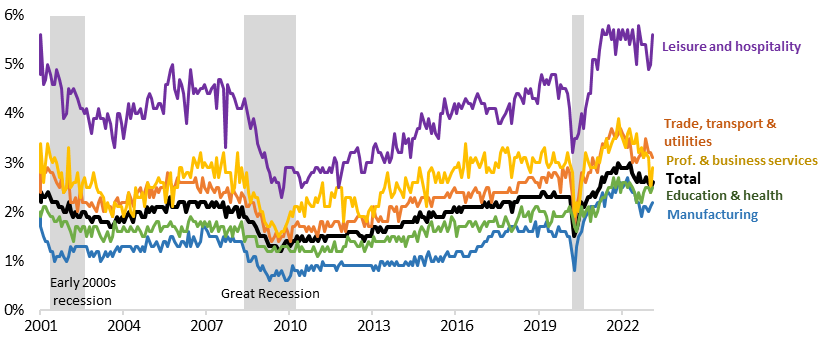Worker Retention
In February, quits remained higher than pre-pandemic, as workers pursued better wages and working conditions in a strong job market.
Quits rate by industry, U.S.
Dec 2000 - Feb 2023
Source: Bureau of Labor Statistics. Notes: The quits rate is the number of quits during the entire month as a percent of total employment. Quits include employees who left voluntarily, except retirements or transfers to other locations. Data is seasonally adjusted. Feb 2023 data is preliminary.
Buoyed by a tight labor market, nearly 50 million American workers quit their jobs over the last 12 months in search of better wages and working conditions. In February alone, 4 million workers quit jobs. Quits rates were highest in the leisure and hospitality (5.6% in February) and retail (3.6% in February) where wages are typically low. The labor market will likely remain constrained for the foreseeable future with approximately 800,000 fewer workers due to excess deaths (Excess deaths).1
The Federal Reserve’s efforts to tame inflation by raising interest rates is aimed at reducing employment growth and increasing unemployment to bring down wage levels.2 When unemployment increases, low-wage workers historically have borne the brunt of job losses. Moreover, recent inflation has been driven by several factors, including supply chain breakdowns and corporate profits surging – neither of which will be corrected through rising interest rates.3 The Inflation Reduction Act and the CHIPS and Science Act aim to reduce inflation by addressing supply chain issues, while containing key healthcare costs.4,5 Meanwhile, the 12-month inflation rate has been decreasing steadily (down to 5% in March 2023) since June 2022 when it was 9.1%.6
“Who’s missing from the post-pandemic labor force?” Bauer, Edelberg, Estep, and Hershbein. Brookings. April, 2023. https://www.brookings.edu/2023/04/04/whos-missing-from-the-post-pandemic-labor-force/
“Federal Funds Effective Rate”. FRED. https://fred.stlouisfed.org/series/FEDFUNDS
“Wages and Employment Do Not Have To Decline To Bring Down Inflation”. Schweitzer, Khattar. Center for American Progress. September, 2022. https://www.americanprogress.org/article/wages-and-employment-do-not-have-to-decline-to-bring-down-inflation/
“FACT SHEET: The Inflation Reduction Act Supports Workers and Families”. The White House. August, 2022. https://www.whitehouse.gov/briefing-room/statements-releases/2022/08/19/fact-sheet-the-inflation-reduction-act-supports-workers-and-families/
“FACT SHEET: CHIPS and Science Act Will Lower Costs, Create Jobs, Strengthen Supply Chains, and Counter China”. The White House. August, 2022. https://www.whitehouse.gov/briefing-room/statements-releases/2022/08/09/fact-sheet-chips-and-science-act-will-lower-costs-create-jobs-strengthen-supply-chains-and-counter-china/
“12-month percentage change, Consumer Price Index, selected categories”. U.S. Bureau of Labor Statistics. https://www.bls.gov/charts/consumer-price-index/consumer-price-index-by-category-line-chart.htm

